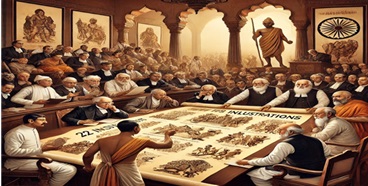Why in the NEWS?
- The issue was raised in the Rajya Sabha that most of the copies of the Constitution currently available do not include the 22 illustrations made by Nandalal Bose.

Key Points:
- The original copy of the Indian Constitution contains 22 illustrations, which depict the rich cultural and historical heritage of the country.
- These paintings were created by renowned painter Nandalal Bose and his associates.
- Each illustration is located at the beginning of a part of the Constitution and depicts various important periods and personalities from Indian history.
What will you read next in this topic?
- Painting of Indian Constitution
- Description of the 22 pictures of the Constitution:
Painting of Indian Constitution
Calligraphy and Illustrations
- The Constitution was handwritten by calligrapher Prem Bihari Narayan Raizada.
- The paintings were conceived and executed by Nandalal Bose and his team at Shantiniketan.
- The paintings reflect Indian history, from the Indus Valley Civilisation to the freedom struggle.
- Scenes from the Ramayana and the Mahabharata are also depicted.
- India's geographical diversity is also depicted in the paintings, such as camel rides in the desert and views of the Himalayas.
The purpose of the paintings
- Not to depict the contents of the Constitution, but to present the historical and cultural perspective of India.
- According to art historian R. Siva Kumar, the paintings present the history of India from Nandalal Bose's perspective.
Appointment of artists
- In October 1949, before the last session of the Constituent Assembly, Nandalal Bose was assigned the task.
- His associates included Kripal Singh Shekhawat, A. Perumal and Direndrakrishna Deb Burman.
- The intricate patterns on the Preamble page were designed by Behar Ram Manohar Sinha, and the national emblem Ashoka Pillar was designed by Dinanath Bhargava.
- Artists who painted historical scenes were paid Rs 25 per page.
- The two copies of the Constitution (English and Hindi) are handwritten and illustrated.
- Today these copies are preserved in special helium-filled cases in the Indian Parliament Library.
Description of the 22 pictures of the Constitution:
- Indus Valley Civilisation: The first picture depicts the Great Bath of Mohenjo-Daro, which symbolizes the advanced city planning and culture of the ancient Indus Valley Civilisation.
- Gurukul System: The second picture depicts the Gurukul of the Vedic period, in which teachers and disciples are shown receiving education in natural surroundings.
- Scene from Ramayana: The third picture is related to the Ramayana, in which Lord Rama, Sita and Lakshmana are shown returning to Ayodhya in the Pushpaka Vimana.
- Scene from Mahabharata: The fourth picture is of the Kurukshetra war of the Mahabharata, in which Lord Krishna is shown preaching the Gita to Arjuna.
- Gautam Buddha: The fifth picture shows Lord Buddha attaining enlightenment at Bodh Gaya, which points to the basic principles of Buddhism.
- Lord Mahavira: The sixth picture shows Lord Mahavira in a meditative state, which symbolizes the principles of non-violence and truth of Jainism.
- Emperor Ashoka: The seventh picture shows Emperor Ashoka preaching Buddhism, which reflects his message of Dhamma propagation and peace.
- Gupta period art: The eighth picture displays the art of the Gupta dynasty, which includes a scene of Hanuman ji, which shows the rich cultural heritage of that time.
- Vikramaditya's court: The ninth picture is of the court of King Vikramaditya, in which he is shown sitting on the throne Battisi.
- Nalanda University: The tenth picture displays the seal and picture of the ancient Nalanda University, which shows the high standards of education in ancient India.
- King Bharat: The eleventh picture shows King Bharat standing with a horse, which symbolizes the naming of India.
- Nataraja: The twelfth picture shows the statue of Nataraja, in which Lord Shiva is shown performing the Tandava dance, which symbolizes the cycle of creation, preservation and destruction.
- Bhagirath's Penance: The thirteenth picture shows the penance of King Bhagirath, which resulted in the descent of Ganga to earth.
- Akbar's Court: The fourteenth picture is of the court of Mughal emperor Akbar, in which he is shown sitting with his courtiers.
- Chhatrapati Shivaji and Guru Gobind Singh: The fifteenth picture displays the Maratha ruler Chhatrapati Shivaji and the tenth Guru of the Sikhs, Guru Gobind Singh.
- Rani Laxmibai and Tipu Sultan: The sixteenth picture shows the heroes of the freedom struggle, Rani Laxmibai and Tipu Sultan.
- Mahatma Gandhi: The seventeenth picture displays Mahatma Gandhi's Dandi March, famous as the Salt Satyagraha.
- Gandhiji in Noakhali: The eighteenth picture shows Mahatma Gandhi among the riot victims in Noakhali, which shows his message of non-violence and peace.
- Netaji Subhash Chandra Bose: The nineteenth picture shows Netaji Subhash Chandra Bose with the Azad Hind Fauj.
- Himalayan view: The twentieth picture depicts the Himalayan range, which symbolises the geographical diversity of India.
- Desert view: The twenty-first picture depicts the Thar Desert, which symbolises the geographical diversity of the country.
- Ocean view: The twenty-second picture depicts the Indian Ocean, which symbolises the maritime boundaries and marine wealth of India.
|
Q. Where are the original copies of the Indian Constitution currently kept?
(a) Rashtrapati Bhavan
(b) Indian Parliament Library
(c) National Archives
(d) Supreme Court of India
|



